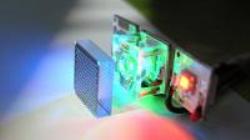Following the development of projector at the Fraunhofer Institute for Applied Optics and Precision Engineering IOF in Jena, the researchers now resolved the imaging problem in LED projectors.
 The LED projector consists of an array of hundreds of tiny microprojectors
The LED projector consists of an array of hundreds of tiny microprojectors
According to Researcher Marcel Sieler of IOF, the array projection technology has been formulated depicting the compound eye present in some insects. For the first time, very thin and bright LED projection systems with excellent imaging properties can be created.
During vertical projection onto a level surface, each tiny projector within the system generates the same image on the viewing surface. An overall bright picture is created by overlapping individual images. On placing the device at an angle to the screen, each projector generates somewhat different image. The overall picture is based on the geometry of the "screen" and the function of the angle where the image is projected. Also the projector in the array has a dissimilar idea of the overall scene. The micro lenses’ large depth of focus allows major features such as projector's "tailored focus" capability using free-form screen geometries like curved surfaces.
Based on specific software designed by researchers, the individual images are computed. The smartphone's camera and the position sensor can provide the geometric information, software then efficiently performs the calculations, followed by computing the individual images with focus setting.
The optics was built on wafers with almost 300 chips, each of those containing 200 lenses for the microprojectors.
The projectors will be introduced in another four years. The prototype of the new LED projector will be debuted at the Optatec trade fair from May 22-25 in Frankfurt. The researchers will exhibit the prototype, which is ideal for initial use on static images. The device is compact and measures only 2 x 2 cm.